 |
|
 |
November 2012 |
 |
|

|
 |
Feature Article
|
 |
 |
Powering the Next Generation of Consumer Mobile Devices
Dan Friel, Director of Systems Engineering, Leyden Energy
Today’s consumers have never held more computing power in their pockets or purses. Mobile innovation is accelerating at an unprecedented rate as device manufacturers push the envelope of features and performance, as carriers race to keep pace with faster infrastructure, and as consumer demand grows for the newest capabilities in the sleekest packaging. ...read more
|
|
 |
 |
| |
Sponsored Announcement |
 |
Microchip Launches 8-bit Microcontrollers with Integrated Configurable Logic in 6- to 20-pin Packages
The PIC10F(LF)32X and PIC1XF(LF)150X MCUs each feature new peripherals, including Configurable Logic Cells (CLCs), Complementary Waveform Generators (CWGs) and Numerically Controlled Oscillators (NCOs), enabling functionality that was not possible before with low pincount MCUs. These general-purpose MCUs enable designers to enhance the functionality, reduce design size, and decrease the cost and power consumption of products.
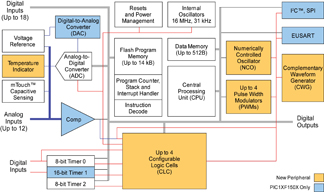
The CLC peripherals on the PIC10F(LF)32X and PIC1XF(LF)150X MCUs enable software control of combinational and sequential logic, which increases the on-chip interconnection of peripherals and I/Os, thereby reducing external components, saving code space and adding functionality. The CWG peripheral works with multiple peripherals to generate complementary waveforms with dead-band control and auto shutdown, which provides improved switching efficiencies. Additionally, the NCO peripheral enables linear frequency control and high resolution, which is required for applications such as lighting ballast, tone generation and other resonant control circuits. The MCUs also feature low power consumption, with currents of less than 30 µA/MHz in active mode, and less than 20 nA in sleep; as well as an on-chip 16 MHz internal oscillator, Analog-to-Digital Converter (ADC), and up to 4 Pulse-Width Modulation peripherals. An integrated temperature-indicator module enables low-cost temperature measurements.
To facilitate application development, the PICDEM Lab Development Kit (part # DM163045, $134.99) now includes samples of both the PIC10F322 and PIC16F1507 MCUs. Additionally, the F1 Evaluation Platform (part # DM164130-1, $39.99) is available for development with enhanced mid-range core 8-bit PIC MCUs, including the PIC1XF(LF)150X family. Also available is a free CLC Configuration Tool, to streamline the setup process of the CLC module by simulating the functionality of the registers and combinational logic in a graphical user interface (GUI).
The PIC10F(LF)320 and PIC10F(LF)322 MCUs are available in a 6-pin SOT-23 package, as well as 8-pin PDIP and 2 mm x 3 mm DFN packages. The PIC12F(LF)1501 MCU will be available in 8-pin PDIP, SOIC, MSOP and 2 mm x 3 mm DFN packages, and the PIC16F(LF)1503 MCU in 14-pin PDIP, SOIC and TSSOP packages, as well as a 3 mm x 3 mm QFN package. The PIC16F(LF)1507 MCU is available in 20-pin SSOP, PDIP, SOIC, and 4 mm x 4 mm QFN packages, as will the PIC16F(LF)1508/9 MCUs, when available. Pricing starts at $0.37 each, in 10,000-unit quantities.
Click here for more information.
|
 |
 |
| |
New Products |
| |
Alpha Technologies Launches Line Power Products
Alpha Technologies Ltd. has announced the release of two new line power products. The next generation Cordex HP LPS36 is a compact, modular DC to DC up-converter system designed for powering distributed communication networks using +/-190 VDC (RFT-V circuit) over an existing copper network. It features modular, high efficiency, quad output converter modules along with an intelligent controller. Applications include powering DSLAM's as well as the Optical Network Terminals (ONT) in FTTH Networks. The Cordex HP LPS36 can be installed in the Central Office or in a remote OSP cabinet. Line powering uses the CO or RT backup power system as the source, eliminating the need for AC utility or battery backup at the remote site, thus reducing truck rolls and operating expenses.
"The Cordex HP LPS36 is a breakthrough product," said Mourad Chergui, product manager – DC Products at Alpha Technologies. "It offers greater than 50 percent more density than the present generation of products, and it is truly environmentally friendly. Besides eliminating the need for batteries at the customer's premises, the LPS36 generates nearly 50 percent less wasted energy than today's products."
The Alpha SR-12190 is a compact DC to DC downconverter that transforms ±190 VDC into 12 VDC for powering the ONT in a FTTH network. Designed for outdoor environments, the compact, self-enclosed design is ideal for mounting on the side of the house, nearby the ONT. It is equipped with a built-in capacitor to ensure continuous operation, even during brief electrical surges. Unlike other downconverters, the SR-12190 provides a 12 V output designed specifically for powering ONTs.
Toshiba Launches Li-Ion Battery Monitor Chipset for Automotive Applications
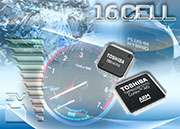 Toshiba America Electronic Component, Inc. (TAEC), Corp. has announced its Li-ion battery monitor chipset for automotive applications. The chipset includes the industry's first battery monitor IC capable of checking up to 16 cells per one IC, which simplifies design and lowers costs by reducing the number of components required in an automotive battery monitoring system. The Toshiba chipset is well suited for hybrid electric vehicles (HEV) and electric vehicles (EV), which require enhanced battery technology. Toshiba America Electronic Component, Inc. (TAEC), Corp. has announced its Li-ion battery monitor chipset for automotive applications. The chipset includes the industry's first battery monitor IC capable of checking up to 16 cells per one IC, which simplifies design and lowers costs by reducing the number of components required in an automotive battery monitoring system. The Toshiba chipset is well suited for hybrid electric vehicles (HEV) and electric vehicles (EV), which require enhanced battery technology.
"With increasing interest and adoption of electric cars, there is a growing need for chipsets that can improve the performance of the battery operation of these vehicles," said Deepak Mithani, director analog and imaging business unit, System LSI Group . "Our battery monitor chipset helps improve driving range and battery life and reduces battery costs, significant challenges for electric vehicles. We intend to aggressively expand into the battery monitor chipset business and continue providing solutions that support the unique requirements of hybrid and electric automobiles."
Toshiba's Li-ion battery monitor chipset is comprised of the TB9141FG 16-channel battery monitor IC and the TMPM358FDTFG automotive safety microcontroller. The chipset detects remaining battery levels, equalizes charging among the cells in a battery pack (cell balancing) and can also detect abnormal battery conditions.
The TB9141FG uses a 96 V mixed-signal process that allows it to monitor up to 16 cells at the same time. It also incorporates cell balancing switches for each cell and is able to measure battery voltage while cell balancing. The TB9141FG is able to communicate in a noisy environment, using differential signaling in a daisy chain communication link between two or more TB9141FGs, an important feature for automotive applications.
The TMPM358FDTFG is a 32-bit RISC microcontroller built around an ARM Cortex-M3 core and is compliant with functional safety standards such as IEC61508/ISO26262. Toshiba will provide a software library developed under an ISO26262 certified software development process to help make it easier for customers to build a safer and more reliable battery monitoring system. The TMPM358FDTFG is designed to be used in a fault-tolerant system and includes a backup power supply for timer circuits and for retaining data in a stand-by SRAM. When it is not monitoring batteries, the TMPM358FDTFG can enter a low-power stand-by mode, leading to lower power for the total system.
The Toshiba Li-ion battery monitoring chipset, TB9141FG and TMPM358FDTFG, begins sampling in first quarter 2013. Volume production is expected by April 2014.
EnerSys Introduces Premium Lithium and Advanced Lead Material Handling Solutions
EnerSys has extended Hawker XFC premium product line for material handling equipment. The two new products feature EnerSys' advanced lithium and thin plate pure lead advanced lead batteries packaged with on board chargers and controls.
"The new solutions are a result of EnerSys' continued investments and commitments to deliver innovative, best value solutions utilizing the latest technologies in energy storage and electronics to make it easier for our customers," stated John D. Craig, chairman, president and CEO of EnerSys. "These batteries are designed to require less time to recharge by employing rapid charging so users do not have to change batteries on the trucks. In addition, these batteries have the added benefit of true maintenance free operation."
These new products are initially being launched in EnerSys' European market with global distribution to follow through our market leading position in energy storage solutions for material handling applications, stretching from the Americas to Asia.
TI Transforms Mobile Charging Experience with Wireless Power
Making wireless power a reality, Texas Instruments, Inc. (TI) has introduced its first single-chip wireless power receiver with integrated battery charger and a new "free-position" transmitter integrated circuit, which expands the charge area by 400 percent. The two bqTESLA circuits give smartphone users a simpler, stress-free charging experience and help designers implement wireless power technology in more places, such as automotive consoles, charging pads and office furniture.
TI's bq51050B is the industry's first Wireless Power Consortium (WPC) 1.1 Qi-compliant wireless power receiver with integrated direct battery charger, and enables faster, more efficient charging of smartphones, wireless keyboards and other portable electronics. The unique 20-V receiver combines rectification, voltage conditioning, communication control and Li-Ion charging capability in a single, tiny integrated circuit, eliminating the need for a separate battery charger circuit. The inductor-free, single-stage design delivers the industry's highest system efficiency and saves up to 60-percent board space compared to a multi-stage implementation.
In addition to the receiver, TI's bq500410A is the first WPC 1.1-ready wireless power transfer controller to support A6 transmitters. The controller allows a Qi-compliant smartphone or other portable device to charge in a surface area of at least 70 mm by 20 mm, 400-percent larger compared to today's 18-mm by 18-mm "bull's-eye" charge space. The bq500410A achieves greater than 70-percent efficiency, and relies on a unique parasitic metal and foreign object detection feature to safely protect the system and stop delivering power if a metal object is detected between the transmitter and receiver.
Wireless power is an emerging technology that creates a better charging experience for consumers, just as Wi-Fi replaced the need to use an Ethernet cable for Internet connectivity. TI's advanced receiver and transmitter integrated circuits, design tools and resources are making wireless power a reality. TI has current solutions that support Qi-compliant devices, and will expand its portfolio to support future, viable technologies. As the leading provider of power management ICs, including battery management and power supply technology, TI relies on power design expertise to drive innovations in wireless charging.
The bq51050B comes in a 1.9-mm by 3.0-mm WCSP package or 4.5-mm by 3.5-mm QFN, and is priced at US$2.75 in 1,000-unit quantities. A bq51051B version with 4.35-V charge voltage is available. The bq500410A comes in a 48-pin, 7-mm by 7-mm QFN package, and is priced at US$3.18 in 1,000-unit quantities.
|
| |
Industry News |
| |
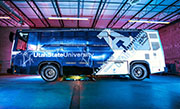 Utah State University Unveils Wirelessly Charged Electric Bus Utah State University Unveils Wirelessly Charged Electric Bus
Utah State University has demonstrated a first-of-its-kind electric bus that is charged through wireless charging technology. The Aggie Bus rolled onto the streets carrying passengers; 16 months after USU demonstrated the first high-power, high-efficiency wireless power transfer system capable of transferring enough energy to quickly charge an electric vehicle. In July 2011, the USU Research Foundation demonstrated 90 percent electrical transfer efficiency of five kilowatts over an air gap of 10 inches. The demonstration validated that electric vehicles can efficiently be charged with wireless technology.
USU's Wireless Power Transfer team, in cooperation with the Utah Science Technology and Research initiative's Advanced Transportation Institute at USU, has designed a more efficient way to meet the nation's transportation needs. By carefully applying a mix of modern advances in engineering and Nikola Tesla's principles of induction, USU engineer Hunter Wu and his team have solved one of today's vexing problems in WPT. Their research has led to the development of a robust prototype, which has been fitted to the Aggie Bus. The prototype transfers power over an air gap where no physical contact is required. Wireless power transfer technology delivers a multitude of benefits to consumers that include greater reliability due to no moving parts or cords, added convenience through the elimination of plug-in charging, the assurance of safety by removing the risk of electrocution and aesthetically pleasing devices as a result of no visible wiring.
USU's Aggie Bus has achieved several significant milestones. It is the first bus developed and designed by a North American organization that is charged with wireless power transfer technology and is the world's first electric bus with WPT technology combining the three following performance metrics: A power level up to 25 kilowatts, greater than 90 percent efficiency from the power grid to the battery and a maximum misalignment of up to six inches.
WAVE Inc., a Utah State University spin-out company, worked in cooperation with the USTAR Advanced Transportation Institute to develop the Aggie Bus. WAVE tackles the problem of heavy and expensive electric vehicle batteries through wireless power that transfers electricity between vehicles and the roadway. The Aggie Bus represents a market-ready product that will be used to retire significant technical risk as WAVE moves onto full-scale projects next year. WAVE, in partnership with the Utah Transit Authority, will launch its first commercial demonstration in mid-2013 on the University of Utah's campus. It will feature a 40-foot transit bus on a public transit route and an increase in wireless power transfer charging from 25 kilowatts to 50 kilowatts. The project has been funded by a $2.7 million TIGGER grant from the Federal Transit Administration and the University of Utah which purchased the bus. WAVE intends to deliver a commercially ready product that operates with the same reliability as current public transit bus options, including diesel and compressed natural gas buses.
"Current battery limitations prevent an all-electric transit bus from operating all day from an overnight charge. WAVE solves that problem by charging the bus wirelessly during its daily operations when the bus stops to load and off-load passengers," said Wesley Smith, CEO of WAVE. "This technology makes electric buses competitive with their diesel hybrid and CNG counterparts."
Lithium-Ion Batteries Demonstrate Their Safety in Fire Tests
DEKRA Automobil GmbH has spent a long time focusing on the safety of electric vehicles. In this series of tests, three traction batteries from an electric vehicle currently on the market were set alight and then extinguished using different extinguishing agents.
The batteries were set alight with petrol. After a few minutes exposed to flames at temperatures exceeding 800°C, the batteries began to burn by themselves. Here, flame and smoke development was much less than with burning petrol. The excess pressure generated inside the batteries as a result of the fire was dissipated outwards through the in-built pressure relief valves. This caused smaller flash fires, although these were less intense than those seen in petrol fires.
The experts used a variety of means to test how burning traction batteries can be extinguished. In the first test of the series, they fought the fire with water. Although this was successful, it did take time. Several times the fire went out only to flare up again. This shows that the vehicle or battery housing need to be cooled down once the fire itself has been extinguished. Overall, considerably more water was consumed in this test than would be required for extinguishing fires in conventional vehicles.
In the two follow-up tests, different additives were used for enhancing the extinguishing and cooling effect of the water. One of the two agents creates a gel when mixed with water, which then does not flow away as easily, but remains on the burning object and thus cools much more effectively. The other additive reduces the water's surface tension and increases its evaporation rate. This also enhances the cooling effect.
All in all, the accident researchers concluded that, in the event of a fire, electric and hybrid vehicles equipped with lithium-ion traction batteries are at least as safe as petrol or diesel cars. The water that was flowing away from the scene was also analyzed. The analysis conducted in the DEKRA laboratory for environmental and product analysis showed that the level of contamination is comparable to that seen in the water used to extinguish fires in conventional cars.
Exide Technologies and Maxwell Technologies Form Strategic Alliance to Develop and Market Integrated Battery-Ultracapacitor Energy Solutions
Exide Technologies and Maxwell Technologies, Inc. have formed a strategic alliance. The two companies will work together in the development and marketing of advanced, integrated, battery-ultracapacitor energy storage solutions to be used in a wide array of transportation and industrial applications.
“The integrated products developed through our alliance with Maxwell Technologies will provide a wide range of benefits for users who require the most that today’s battery technology has to offer,” said Paul Cheeseman, Exide’s vice president, Global Engineering and Research. “These benefits will include high energy density, rapid charging and discharging, extended operational life and superior performance in extreme temperatures.”
Exide is the only battery company to provide product offerings across a range of applications in both the transportation and industrial markets. With its AGM (Absorbent Glass Mat) technology that allows for deep cycling combined with high charge acceptance, Exide supports Start-Stop vehicles, energy recuperation, intelligent charging and other advanced power train features to reduce CO2 emissions and fuel consumption.
“Exide’s battery technology leadership, extensive manufacturing capabilities, established global distribution channels and strong existing industrial and transportation customer relationships make it an ideal alliance partner,” said David Schramm, Maxwell’s president and chief executive officer. “We have always believed in the synergistic nature of ultracapacitors and batteries, and this relationship will enable us to significantly accelerate development of products embodying the benefits of both technologies.”
Maxwell’s ultracapacitor products store energy in an electric field, which is unlike batteries that produce and store energy by means of a chemical reaction, This electrostatic energy storage mechanism enables ultracapacitors to charge and discharge in as little as fractions of a second, perform normally over a broad temperature range (-40°C to 65°C), and operate reliably for one million or more charge/discharge cycles. Maxwell offers ultracapacitor cells ranging in capacitance from one to 3,000 farads and multi-cell modules ranging from 16 to 125 volts.
|
| |

|
 |
Event Listings |
 |
 |
 Battery Power 2013 Battery Power 2013
Battery Power 2013, an international conference highlighting the latest developments and technologies in the battery industry, will be held June 6-7 in Denver, Colorado. This 11th annual event will feature more than 35 presentations on portable, mobile and consumer battery technology, as well as battery manufacturing, materials and research & development, serving the consumer electronic, medical and military industries.
Topics will include new battery designs, emerging technologies, battery materials, power management, charging and testing systems, battery health, as well as the latest market trends affecting the industry. The conference is designed for OEM design engineers and system engineers involved in battery powered products and systems and power management technology, as well as battery pack and cell manufacturers.
Battery Power 2013 will provide you with the most up-to-date developments and technologies in the portable/mobile/consumer battery and power management market. If you are involved in the battery industry or if your products and systems run on batteries, this is a must attend event.
Call for Presentations
Battery Power 2013 is currently accepting abstracts. The international event will explore the important topics impacting battery power systems used in consumer electronics, medical and military markets. Topics will include design issues in battery cells and packs and emerging charging technologies to predicting battery failure and battery hybrid systems. Other topics include cell design and manufacturing, power management, testing, materials, market trends and end-user requirements for new applications.
The conference provides an excellent forum to discuss new developments in technology, market conditions and end-user requirements that are driving innovation, capabilities and features, application trends and performance improvements.
Attendees include top executives, technical managers and engineering professionals from battery pack and cell manufacturers, original equipment manufacturers, system developers and integrators, dealers and component providers.
Call for Presentations • Exhibitor Information
|
 |
 |
|
 |
 |
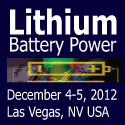 Lithium Battery Power Lithium Battery Power
December 4-5
Las Vegas, Nev.
Recent significant innovations within lithium-ion batteries have propelled the technology into a position in the marketplace far exceeding recent market survey results. Breakthroughs in new battery chemistries, novel electrode and electrolyte materials, system integration for a vast array of mobile and portable applications, from micro medical devices to high-energy/high-power automotive, have paved the roadmap for an emerging market with unlimited potential.
- New chemistries & materials to increase energy & decrease cost
- Meeting the EV challenge: cycle life, power & energy, cost and safety
- Advanced materials for improved electrode & electrolyte performance
- Application driven lithium ion battery development
- Advanced technology for greater safety, reliability and performance
- From novel materials and components to systems design and integration
- Role of nanotechnology in improving power and energy density
3rd Annual Electric Energy Storage Conference
January 8-10, 2013
The Embassy Suites Biltmore, Phoenix, AZ
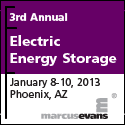 The 3rd Annual Electric Energy Storage Conference will be a two and a half-day, industry focused event, specific to those within EnergyStorage, Renewable Energy, Regulatory Policy and Planning and Research and Development. This conference will bring together the leading senior executives from PJM Interconnection, Luminant, NERC, MISO, Southern California Edison and many more to discuss technological advances and case studies, while focusing on the tools and strategies necessary to bring energy storage operations into real time energy operations. The 3rd Annual Electric Energy Storage Conference will be a two and a half-day, industry focused event, specific to those within EnergyStorage, Renewable Energy, Regulatory Policy and Planning and Research and Development. This conference will bring together the leading senior executives from PJM Interconnection, Luminant, NERC, MISO, Southern California Edison and many more to discuss technological advances and case studies, while focusing on the tools and strategies necessary to bring energy storage operations into real time energy operations.
|
 |
| |
Contact Us |
|
| |
Submit editorial content to Shannon Given at 608-351-9245
For advertising information contact Jeremy Fleming at 800-803-9488 X121
Webcom Communications • 7355 E. Orchard Road, Suite 100; Greenwood Village, CO 80111
Phone: 800-803-9488 • Fax: 720-528-3771 • www.infowebcom.com |
|
| |
© 2012 Webcom Communications Corp. |
|
|
|
|
|
|